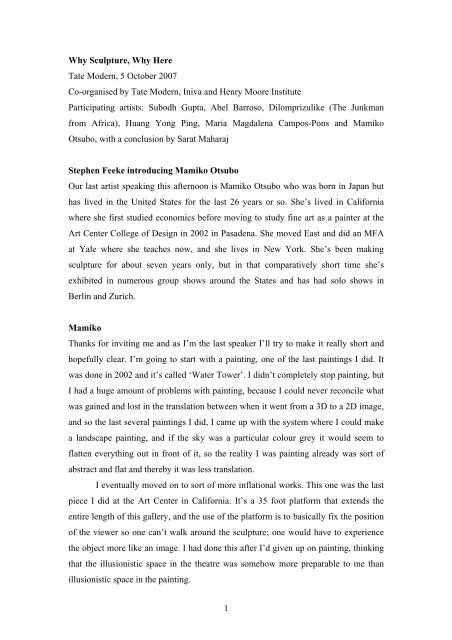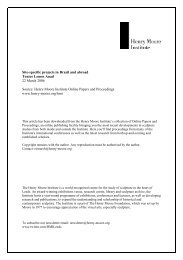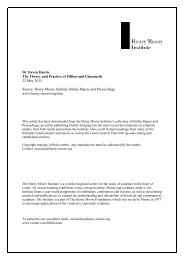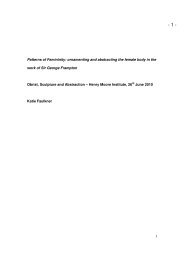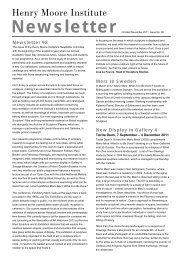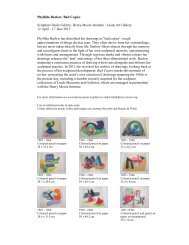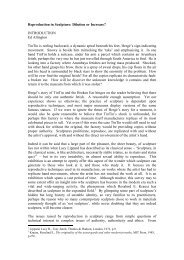pdf download - The Henry Moore Foundation
pdf download - The Henry Moore Foundation
pdf download - The Henry Moore Foundation
You also want an ePaper? Increase the reach of your titles
YUMPU automatically turns print PDFs into web optimized ePapers that Google loves.
Why Sculpture, Why Here<br />
Tate Modern, 5 October 2007<br />
Co-organised by Tate Modern, Iniva and <strong>Henry</strong> <strong>Moore</strong> Institute<br />
Participating artists: Subodh Gupta, Abel Barroso, Dilomprizulike (<strong>The</strong> Junkman<br />
from Africa), Huang Yong Ping, Maria Magdalena Campos-Pons and Mamiko<br />
Otsubo, with a conclusion by Sarat Maharaj<br />
Stephen Feeke introducing Mamiko Otsubo<br />
Our last artist speaking this afternoon is Mamiko Otsubo who was born in Japan but<br />
has lived in the United States for the last 26 years or so. She’s lived in California<br />
where she first studied economics before moving to study fine art as a painter at the<br />
Art Center College of Design in 2002 in Pasadena. She moved East and did an MFA<br />
at Yale where she teaches now, and she lives in New York. She’s been making<br />
sculpture for about seven years only, but in that comparatively short time she’s<br />
exhibited in numerous group shows around the States and has had solo shows in<br />
Berlin and Zurich.<br />
Mamiko<br />
Thanks for inviting me and as I’m the last speaker I’ll try to make it really short and<br />
hopefully clear. I’m going to start with a painting, one of the last paintings I did. It<br />
was done in 2002 and it’s called ‘Water Tower’. I didn’t completely stop painting, but<br />
I had a huge amount of problems with painting, because I could never reconcile what<br />
was gained and lost in the translation between when it went from a 3D to a 2D image,<br />
and so the last several paintings I did, I came up with the system where I could make<br />
a landscape painting, and if the sky was a particular colour grey it would seem to<br />
flatten everything out in front of it, so the reality I was painting already was sort of<br />
abstract and flat and thereby it was less translation.<br />
I eventually moved on to sort of more inflational works. This one was the last<br />
piece I did at the Art Center in California. It’s a 35 foot platform that extends the<br />
entire length of this gallery, and the use of the platform is to basically fix the position<br />
of the viewer so one can’t walk around the sculpture; one would have to experience<br />
the object more like an image. I had done this after I’d given up on painting, thinking<br />
that the illusionistic space in the theatre was somehow more preparable to me than<br />
illusionistic space in the painting.<br />
1
And then I moved to the East coast. This piece is called ‘Barely American’,<br />
and I carved it using an electric chainsaw. It’s a little bit of a rare piece that I’m<br />
showing, it’s probably the only piece that has anything directly to do with identity. I<br />
used to often get comments that my work looked really Japanese and I was<br />
particularly irritated and also kind of curious why that kept coming up – considering<br />
that I have lived in the States for 26 years and never had an interesting conversation<br />
that started out that way.<br />
I made this piece using a chainsaw and I came up with the idea for it when I<br />
was driving across America to go to graduate school and I saw all these chainsaw<br />
sculptures in the West. To me, that was sort of stereotypically American and also very<br />
typically male; I thought that would be a good point to start making something to see<br />
if it would end up still looking Japanese – you can judge for yourself.<br />
This piece is sort of the first one where I started moving more into making<br />
discrete objects, and by this point I was really sort of anti-installation work and<br />
wanted to make work where the logic was completely self-contained. This is<br />
supposed to be a cloud with a piece of grey sky stuck on it. I wanted to avoid the<br />
situation where the cloud was sort of hanging in space and the viewer was made to<br />
consider the cloud in relation to their own body, so the podium is actually the most<br />
important part of the piece, because it makes it an anti-illusionistic and anti-illustrated<br />
installation, and this reduction of the vast sky into a plane is something that I refer to<br />
in later pieces.<br />
This is a piece I did in 2004, and it’s meant to function like an oversized<br />
model, the kind that you would see in a natural history museum. I’m interested in this<br />
kind of stacking of spaces that happens in old Japanese screen paintings, where things<br />
that are further away are simply higher up on the picture plane and not smaller like in<br />
Western perspective. <strong>The</strong> level of abstraction in this piece increases as you move<br />
further up on it. <strong>The</strong> piece is held up by a 500lb metal plate on the bottom, and the<br />
tree is a real tree which was already dead, I didn’t have to kill it, but it’s sort of<br />
skinned, and the texture of it is made to mimic the way surfaces are done for furniture,<br />
so it’s oiled and waxed to get that sort of shiny surface. And then a cloud is just<br />
represented as a white blob and the sky is reduced to a blue line, and so again here’s<br />
the most enormous thing reduced, which requires the most amount of abstraction.<br />
This is a piece immediately following that one, where I’m still investigating<br />
the stacking of spaces. A lot of these pieces are untitled, I’m not too fond of titles and<br />
2
obviously very much influenced by Brancusi, but maybe filtered through a pop design<br />
aspect of it. <strong>The</strong> sun is a yellow rubber ball that a kid would play with; it had a happy<br />
face on it that I had to sand off.<br />
This next piece is called ‘Carpool is for Lovers’. I don’t know if you have<br />
carpools in England but it’s a thing they have in Southern California to cut down on<br />
the traffic on freeways. It’s meant to look sort of logo-ish and not naturalistic at all; in<br />
fact a lot of the sceneries in my work are not meant to conjure up any images of<br />
nature, but filtered, designed versions of it.<br />
For this piece, I had been looking at a lot of modernist furniture design and<br />
thought that many famous modernist designers stole a lot from modernist sculptors, so<br />
I thought I would steal their design and put it back into the sculpture. So the sun is<br />
based on a Verner Panton flowerpot lamp, and the measurements for the table are<br />
loosely based on a George Nelson table. After I got out of graduate school a year<br />
later, I was given a Public Art Fund commission in New York, where I proposed to<br />
make three pieces for this really rather intense-looking marble corporate lobby. It was<br />
a rather depressing exhibition space, and I actually had a very difficult time with this<br />
piece, and I think, looking back on it, it was probably because it was my first real<br />
opportunity to do something that was left out in the public and that was an exhibition,<br />
but it was full of people who weren’t regular art-going audiences and sort of without<br />
security. <strong>The</strong>y had this marble instead of white walls, so this exhibition was kind of<br />
difficult, but this is a greenhouse piece where the greenhouse serves as a frame for<br />
generic images of what looks like green trees, but when you get up close it’s much<br />
more abstract and all the parts are hand-cast plastic and they’re puzzled together<br />
(there’s no screws, they all just fit together), and the Kartell lamp I used is meant to<br />
look like a low hanging room in a <strong>Henry</strong> Rousseau painting.<br />
This is an installation view of the second piece I did for the Public Art Fund,<br />
and it’s window boxes alongside a wall, windows, some of them have a doubledecker<br />
plug and twin lakes and a sun.<br />
And the third piece that I did for the Public Art Fund are these two mountain<br />
peak pieces, sets of identical pieces that are cast twice. It takes the place of where they<br />
normally have giant flower arrangements for these corporate lobbies, and I thought it<br />
was the perfect view of outside for a corporate lobby because it looks like a logo for a<br />
water bottle or something like that.<br />
3
This is my second attempt at a public sculpture, done in Socrates Sculpture<br />
Park in Long Island City in Queens, which was started by Mark di Suvero. You’re<br />
sort of looking across the East River onto the upper east side of Manhattan, and I<br />
came up with this piece because it’s a long drive to this park, but this part of Brooklyn<br />
and Queens had recently been re-zoned to be completely residential, whereas before,<br />
it was mostly commercial, and so there was an incredible number of condos going up<br />
at a really fast rate. So every day upon driving there I wondered how much longer<br />
they could keep the park before it was turned into a condo, so I thought I would make<br />
a Mies van der Rohe inspired miniature condo inside and outside the park – it sort of<br />
diagonally crosses over the fence.<br />
This is one of the first pieces where I use a real thing and hide it in a cloak of<br />
representation. So that’s actually a miniature Vitra chair you could purchase at a Vitra<br />
store, but inside the vitrine it’s more of a representation of that chair, rather than the<br />
miniature version of it, and the tree that is planted behind it also becomes like a<br />
representation of a tree rather than this plant that’s behind it.<br />
This piece is called ‘Water Tower’, again inspired by Brancusi’s ‘Endless<br />
Column’, but obviously much less heavy and much less monumental. <strong>The</strong> endlessness<br />
is implied simply in not only the use of the same parts just cast in different colours,<br />
but in the fabric-like repetition of colour.<br />
I loosely call these ‘paintings’; they don’t have any paint on them, but they’re<br />
called ‘Stardust 1 and 2’. I still have a desire to make flat works, I just have a hard<br />
time painting, so I always have to come up with excuses to make flat things. So with<br />
this one I made a silicone mould of a canvas stretched on a board and I cast it in<br />
polyurethane and when it’s cast without a vacuum you get all these air bubbles in<br />
your casts. So what I do to get the image is, I sand the surface of it, and once you sand<br />
this air bubble-filled polyurethane, all the dust trapped in the air bubbles makes these<br />
white spots, and so I just sand until I get a configuration of dots that I like. So rather<br />
than putting paint on the surface, you’re sort of excavating to find the image that you<br />
want. I’ve been thinking quite a lot about economy of means and the processes that<br />
you can afford, and this is one of the small discoveries.<br />
This is a piece done in 2006, and the works from hereon are different in that<br />
colour is used more sparingly and the materiality of the pieces is highlighted. That’s a<br />
carved piece of laminated walnut with plaster, glass, a fluorescent juggling ball and an<br />
Eames chair base that you can buy at any design store. I had been thinking quite a lot<br />
4
about economy and means and also about what sculpture competes with nowadays,<br />
and I think, rather than sculpture that came before, it competes for real estate in<br />
people’s homes with fancy designer furniture. And a lot of times, especially in cities<br />
like New York, it loses, because these companies have an extreme amount of research<br />
and facilities that I think individual artists don’t have at their disposal, so I’m<br />
interested in finding a system where I can be above all those things so that my work is<br />
capable of swallowing them. I’m also just irritated by having more and more things<br />
that I’m not supposed to play with – such as a $5,000 chair you can’t even sit on – so<br />
this was my first step in taking something that was already sort of canonised as an<br />
important piece of design and looking to use it like a two-by-four. Obviously I have a<br />
real love-hate relationship with design and from here, I think, all the sculptures start to<br />
become real household size; the pieces before were much bigger simply because I<br />
wasn’t as concerned with this subject.<br />
This piece is called ‘Sitting on Ghosts’; it’s a hand-blown glass globe, cloud<br />
shape on top, that’s fixed to this hand-carved walnut piece by a rubber plug and<br />
stainless steel bent Kartell table, so the materials here are all materials that would be<br />
used in furniture design, but the parts are arranged in a way a designer would never<br />
arrange them, because it’s extremely precarious – they would never put a glass piece<br />
with a rubber plug.<br />
This is a shelf piece done in 2006 with store-bought shelf brackets, and the<br />
shelf is only narrow enough to hold an image of some water cloud and a lightening<br />
bolt.<br />
This is a piece done in 2007; it’s nickel-plated steel, but about half inch in<br />
stock, so it’s super thin, it’s actually probably a quarter of the size of what a normal<br />
table of that size would use, and the top of the table has a hole where the cobalt blue<br />
piece of glass that’s inset into it is barely just sitting there, and the glass also has a<br />
hole with a yellow ball stuck in it.<br />
This is a piece done in 2007; I think the pieces are becoming more and more<br />
minimal at this point where not every piece has to have every part of an image<br />
attached to it, so it’s really like an awkward part coat-rack part table, landscape thing.<br />
This is an umbrella stand that you can purchase from Kartell, with a plaster<br />
cloud attached to it with the threaded metal rod that holds itself upright against the<br />
wall.<br />
5
This is a new group of works that I started earlier this year, and the logic of it<br />
changes with each piece, but this piece, although a side view, is more of an actual<br />
image with these branches possibly in the winter and this cloud floating down the<br />
middle.<br />
This is a piece called ‘Value Pak’; you get a moon, a sun, two clouds and two<br />
branches, and this is a piece called ‘Bonus’ (you get a bonus sun), and this one is<br />
much more graphic than the other two. ‘Value Pak’ consists of all parts of a landscape<br />
you would need to make a landscape painting.<br />
And I’ll finish off with this piece, which is an old piece; it’s called ‘Best<br />
Friends’, and I don’t really have anything to say about it.<br />
Question<br />
I thought it was very interesting to compare your presentation with Maria<br />
Magdalena’s, because they were almost, I felt, coming from opposite directions.<br />
Maria, living in America but continually looking to Cuba, and my feeling was that<br />
your answer to the question ‘Why Sculpture, Why Here’ was all to do with loss and<br />
sculpture was about recuperating loss. And then you mentioned in your talk that no<br />
conversation ever became interesting if it began with the word Japanese, but when I<br />
saw your work a year ago, I thought it looked Japanese, that’s partly why we thought<br />
it might work in this presentation, but I almost felt that you are really trying to<br />
distance yourself from the Japanese, but can I dare ask you, is there still something<br />
Japanese in it?<br />
Mamiko<br />
Well, I’m sure the work can potentially look Japanese more than others, but it’s just<br />
not an active subject matter for me. I’ve lived a long time in the US, but I don’t<br />
necessarily consider myself American, and it’s really a point of contention with<br />
everybody; everybody says, oh, but you’re really American, and I think, yes, it’s<br />
neither or both or I don’t know… I think defining that in the work is not such an<br />
interesting thing for me. I don’t mind talking about it, but I think I haven’t been able<br />
to have a conversation without some sort of profiling that begins to happen, and I’m<br />
just not interested in that.<br />
Question<br />
6
I actually saw a link between the last two speakers; they both referred to space rather<br />
than place, and I wondered whether you’d consider the space of sculpture before the<br />
place of sculpture and whether that overrides this idea of a cultural screen or seeing<br />
sculpture through a cultural screen before its actual being in the world.<br />
Mamiko<br />
Yes, I mean, the way I see it is, when it’s exhibited, it’s always exhibited with my<br />
name attached to it, so it’s impossible to avoid a certain kind of reading that’s<br />
attached to my name – it’s just part of the deal. Sorry, can you repeat your question?<br />
Question<br />
When you’re talking about sculpture, you’re talking about the space in which it exists<br />
rather than the place it’s come from, and with the initial speakers, the work was very<br />
much seen in terms of the place where it was from, but not necessarily the space in<br />
which sculpture exists, and I feel there’s been a journey to a point at which we<br />
shouldn’t necessarily be discussing the place or where things are from but the space in<br />
which sculpture exists.<br />
Mamiko<br />
Yes, I would agree with that.<br />
Question<br />
You mentioned that you were irritated by things a couple of times in your talk, and I<br />
wondered how much a kind of anger about your surroundings, the place or<br />
juxtapositions of things has informed your work?<br />
Mamiko<br />
It’s actually really important for me that the work isn’t just swallowed as this<br />
beautiful, commodified thing, and I think that where and how each of these parts I<br />
actually consider, there is a bit of a violence to them and I don’t know how much<br />
translates in just slides, but I actually think that’s probably the most Japanese part of<br />
the work, but I don’t expect any of you guys to understand that.<br />
Question<br />
7
Is it a combination of beauty and violence and balance?<br />
Mamiko<br />
Well, I think for me, in my sort of chopped up experience of Japan, I’m always really<br />
struck by this willingness to tear down something super old or carry out this strange<br />
illusion about something right next to a concrete factory. You’re always bombarded<br />
with this perfectly packaged cultural historical thing right next to something like<br />
Kiddieland, and there is a kind of violence, and I think I can identify with that<br />
somehow.<br />
Question<br />
I was really struck by what you had to say about design, particularly coming from<br />
where you’re coming from. I’m wondering if you’ve also got similar sorts of irritation<br />
questions or interest in fabrication along the same lines?<br />
Mamiko<br />
Yes, I love those things, but at the same time it was really so irritating that Kartell can<br />
sell a perfectly moulded plexiglas table for $140, whereas if I were to buy and cut the<br />
plexi myself, it would cost me $500 and wouldn’t look half as good. So I wanted to<br />
set up a system for myself where I wasn’t necessarily limited by my resources and<br />
where I could swallow all those things and still make a work that was mine, regardless<br />
of whether it was branded or canonised or MoMA. I think the best thing about being<br />
an artist is that you are at liberty to do that; I want to reserve the right, as an artist, to<br />
be able to use whatever I want.<br />
Question<br />
I was struck that you mentioned Brancusi twice, and it probably relates to some of the<br />
questions about Japaneseness, but I wonder if you could put your finger on what it is<br />
about his work that interests you, or perhaps about his career or the way he crafts a<br />
fashion or identity for himself. What is it about Brancusi apart from perhaps first<br />
looking at the screens, this kind of play of precariousness and balance and piling up?<br />
Can you say a bit more about that?<br />
Mamiko<br />
8
Well, I only mentioned Brancusi because it was relevant to those pieces. I’m also a<br />
huge fan of Alex Katz, but I think the artists that I’m interested in, there’s something<br />
really efficient about their process, but the efficiency doesn’t necessarily mean that<br />
they have to lose something. I’m attracted to this kind of steady, daily practice that<br />
painters can have, which, at least from the kind of work I make, is not possible for<br />
me, and so most artists I’m attracted to seemingly have that kind of consistency, but<br />
within that consistency are able to continually come up with interesting works.<br />
Question<br />
Has anyone compared your work with contemporary visual poetry? That would be my<br />
instinctive response.<br />
Mamiko<br />
No, you’d be the first one.<br />
Transcribed by Jackie Howson and edited by Marion Endt.<br />
9


